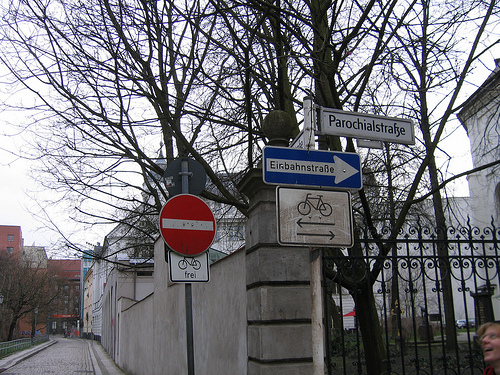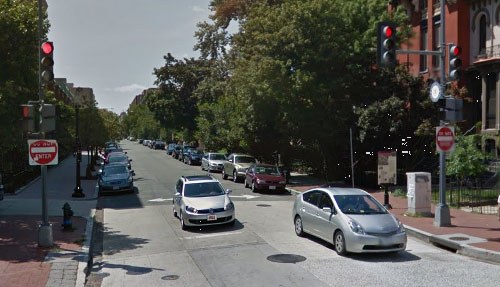Cyclists got tickets for riding on a short one-way half-block. There’s a better way to design this street
Last month, police ticketed bicyclists riding the wrong way on M Street near the Convention Center, POPville reported. We asked our contributors and DDOT what they think is the right solution in this area.
This one-way block of M is essentially only a half block, between 9th Street NW and Blagden Alley, halfway to 8th. Besides this half block, M is two-way from Thomas Circle, at 14th, eastward to 5th Street NW.
DDOT spokesperson Keith St. Clair said a change to one-way appears on convention center plans dating to 2004. Contributors speculated that the construction of the convention center might have spurred the change as a traffic calming measure. The loading dock is on M, one block to the east.
At that time, contraflow bike lanes, which allow cycling in the opposite direction of traffic on an otherwise one-way street, weren’t a regular part of DC’s road design toolbox. Now, DC has several roads with such lanes, including G and I streets NE, on either side of H Street, and New Hampshire Avenue NW for a block on each side of U Street.
Here, the street is the same width east of Blagden (where it’s one-way) as west. This leaves plenty of room for a contraflow lane. St. Clair added,
Safety is our number one priority at DDOT. The law rightly treats cyclists as legitimate users of the roadway, and cyclists are subject to traffic laws for everyone’s safety — especially their own. Without facilities and signage designed to let bikes ride contraflow safely, we don’t support wrong-way bicycling.
That said, M Street east of Thomas Circle is a potential route for improved bike lanes. DDOT is exploring options on how we might proceed. A contraflow lane, similar to what we installed on G and I Streets NE last year, might be possible without modifying vehicular conditions or parking. The results of our analysis will be shared with the public, and their input will be taken into consideration when DDOT finalizes any action plans.
Meanwhile, ride on the sidewalk
Riding on the sidewalk is legal in this area, and some contributors said they do just that. Payton Chung pointed out that DC explicitly encourages this in one spot:
I know of one local precedent for signing a contraflow bike route on the sidewalk. On O Street SW, across from Nats Park, the street goes one-way westbound (away from the stadium) for one block. Eastbound cyclists are directed onto the south sidewalk.
In that situation, though, bicyclists are going uphill to an actuated stoplight at South Capitol Street, and are therefore going slowly past a few houses. The 900 block of M, on the other hand, is leading away from a stoplight and goes past many more houses, few of which might want relatively fast crosstown cyclists riding past their stoops.
If DC were able to follow Europe’s lead, it might be possible to have a contraflow “lane” without even repainting the street. In Germany (as in the picture below), the Netherlands, and elsewhere, some low-speed, low-traffic streets (as M is here) with “do not enter” signs that don’t apply to cyclists.

A Berlin sign exempting cyclists from the “Do Not Enter” restriction. “Frei” is German for free, or clear; this sign says bicycles can still enter while motor vehicles cannot. Photo by Matt’ Johnson on Flickr.
Still, a contraflow lane might be the best approach and aligns with DC’s practice in other areas. It’s good to hear DDOT is considering that option.




